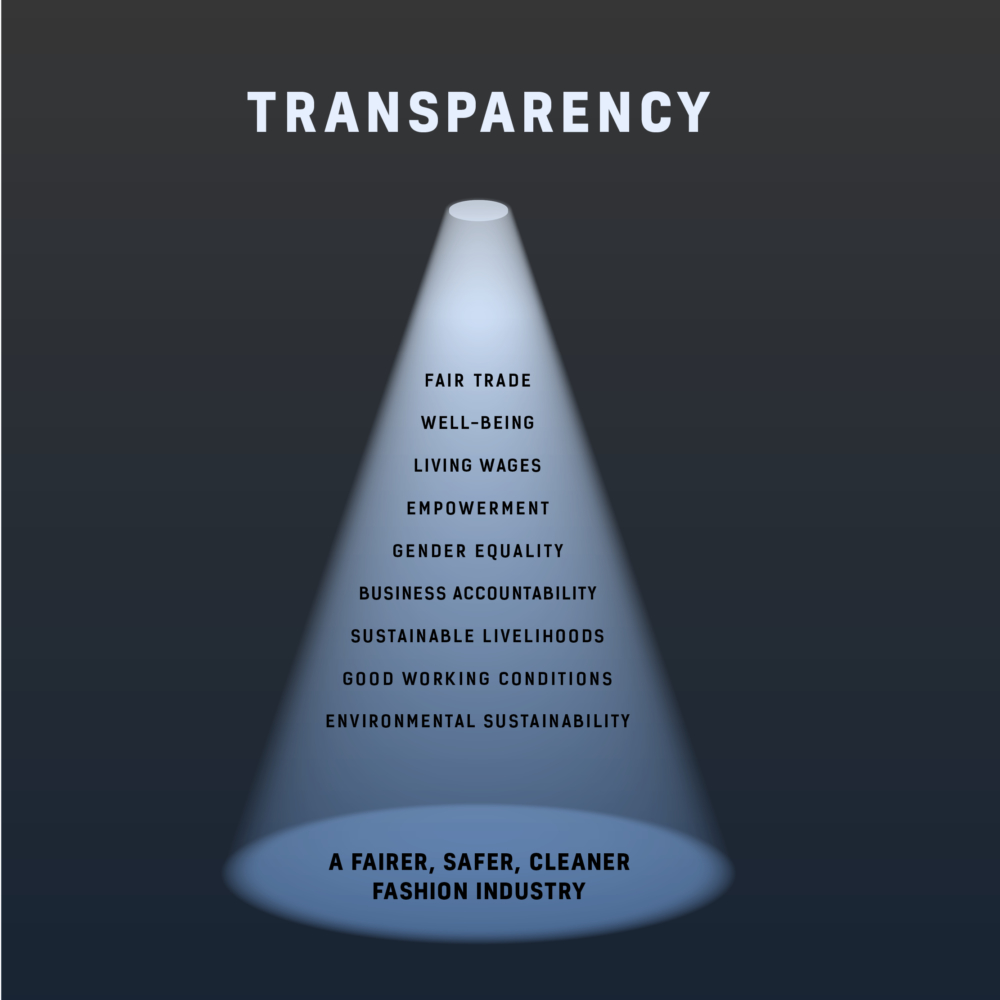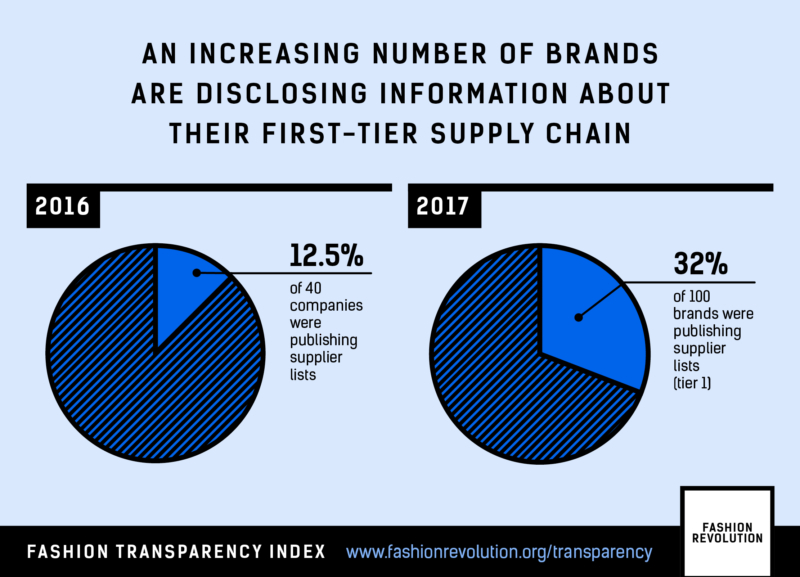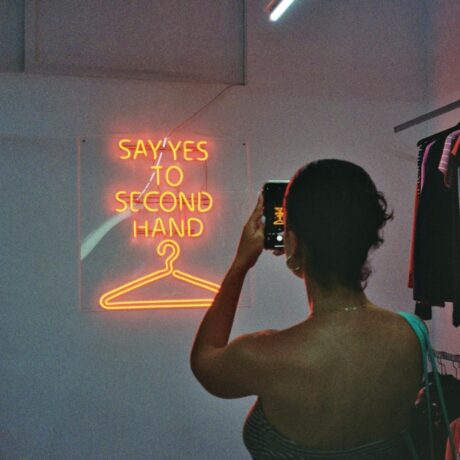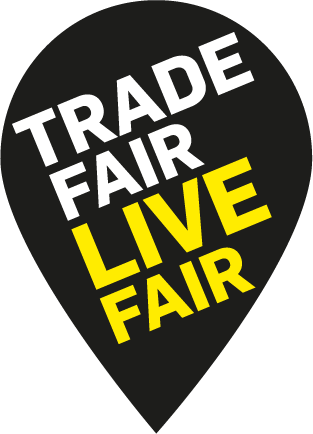FAQs: Fashion Transparency Index 2017
1) What is the Fashion Transparency Index?
The Fashion Transparency Index 2017 reviews and ranks 100 of the biggest global fashion and apparel brands and retailers according to how much information they disclose about their suppliers, supply chain policies and practices, and social and environmental impact.
2) What do you mean by transparency?
For Fashion Revolution, transparency means public disclosure of brands’ policies, procedures, goals and commitments, performance, progress and real-world impacts on workers, communities and the environment.
Transparency requires brands to know exactly who makes their products – from who stitched them right through to who dyed the fabric and who farmed the cotton. And crucially, it requires brands to share this information publicly.
Publishing supplier, supply chain and operational information by companies helps NGOs, unions, local communities and even workers themselves to more swiftly alert brands to human rights and environmental concerns and can also help the company keep track of any unauthorised production units being used to make its products. Transparency aids accountability so that if human rights or environmental abuses are discovered, it is far easier for relevant stakeholders to understand what went wrong, who is responsible and how to fix it.
Transparency helps people who are concerned about the human and environmental impacts of what they buy to make more informed decisions.
However, transparency is a means to change, not an end. Transparency alone does not represent the sort of structural, systemic change we would like to see for the fashion industry — but it helps us get there. It puts the spotlight on issues often left in the dark, such as: living wages, gender equality, working conditions, fair trade and environmental sustainability. Ultimately, we believe transparency is the first step towards creating a fairer, safer, cleaner fashion industry.

3) Why did Fashion Revolution conduct this research; what’s the point?
We had many reasons for putting together the Fashion Transparency Index. First, Fashion Revolution campaigns for greater transparency throughout the fashion industry and our #whomademyclothes social media campaign has inspired thousands of people to take action. To build on and define this work, we wanted to create a tool that would help people better understand what transparency looks like in practice, particularly when it comes to big brands. We wanted to better understand what information these corporate brands are sharing publicly about how they work, what their supply chains look like and who makes their clothes. By doing this research, it has also helped the Fashion Revolution team distill its own understanding of what transparency entails and what it might look like in future. Importantly we believe that greater transparency will lead to greater accountability and eventually a positive change in the way business is done.
Second, citizens are increasingly demanding greater transparency. During Fashion Revolution Week last year, #whomademyclothes reached 129 million people through 70,000 posts on social media. Transparency is quickly becoming the norm as explained in the Business of Fashion in September 2016:
“For decades, a brand’s only priority was to create the best possible product at the most competitive price to ensure sales. But as consumers develop a more comprehensive understanding of issues like sustainability, authenticity and transparency, brands and retailers are being forced to change the way they sell in order to survive”.
Through the Fashion Transparency Index, we want to help people know a bit more about the brands they buy. Many of the brands included in the Fashion Transparency Index are selling special collections that use sustainable materials, but what about the rest of their clothes? Where are their clothes made, by whom and under what conditions? What information should we expect to find about these big brands’ policies, practices and effects on the people who work in their supply chains? These are some of questions the Fashion Transparency Index explores.
We hope the Fashion Transparency Index will help consumers make more informed choices about what they buy. Perhaps consumers will think twice about where they shop if they know more of the story behind these big brands.
Several campaigning organisations such as Labour Behind the Label, Baptist World Aid Australia, Oxfam and Human Rights Watch are pushing brands to disclose their supplier lists, and we hope that the Fashion Transparency Index adds to this momentum.
32 of the 100 brands are publishing their supplier lists at the first tier of production (where clothes are typically cut, sewn and trimmed), compared to 5 out of 40 companies reviewed last year. 14 brands are publishing lists of their processing facilities (e.g. fabric suppliers, sub-contractors or wet-processing facilities), compared to 2 out of 40 companies reviewed last year.

We hope the Fashion Transparency Index helps big brands better understand what information their peers are publishing and motivates brands to disclose more year on year.
4) How did you select the 100 brands to research?
Brands were selected on the basis of two factors: 1) according to annual turnover, over $1.2 billion USD; 2) voluntarily requested to be included after last year’s edition; and 3) representing a variety of market segments including high street, premium, luxury, sportswear, accessories, footwear and denim from across Europe, North America, South America and Asia.
We relied on publicly available financial information. Some big brands are privately held and do not publish financial records, including turnover, which means we were unable to include them in this edition. Where brands are part of a parent company with annual turnover over $1.2 billion USD, we have selected the brand or brands that appear to make up the most significant part of their business.
5) How did you score the brands; what was the methodology?
We used a ratings methodology to benchmark brands across five key areas, including: policy and commitments, governance, traceability, supplier assessment and remediation, and spotlight issues covering the business model, living wages, unionisation and collective bargaining. We awarded scores only for information that has been publicly disclosed. See more below.
View the full methodology here.
6) How was the research conducted?
The Fashion Transparency Index used only publicly disclosed information about each brand’s policies, procedures, performance and progress on human rights and environmental issues across its supply chains. We relied solely on information available on the brands’ websites, in their annual reports (published January 2015 or later), or via third party websites when linked to directly from the brands’ website.
We also sent each brand a questionnaire in order to help us identify where information is publicly disclosed and to clarify information we found through our own research. Brands were given one month to complete the questionnaire. 48% of brands submitted a completed questionnaire. The other 52% did not respond or declined the opportunity to complete the questionnaire. The completed questionnaires were analysed by our research team and scores were awarded where appropriate.
Our team researched and scored brands regardless of whether they completed the questionnaire or not. However, brands that completed the questionnaire were more likely to receive a higher score simply because our researchers will have had more accurate information. Our researchers strived to be as thorough and accurate as possible.
However, there are limits to desk-based research, and only on-the-ground research by NGOs, unions and academics can reveal the impacts of brands’ policies and practices. By encouraging brands to become more transparent, the Fashion Transparency Index will facilitate the work of NGOs, unions and academics.
The research was conducted by Sarah Ditty and Carry Somers, with support from Eloisa Artuso, Sophia Calugay, Ilishio Lovejoy, Aidan Shaw, Sienna Somers and Manon Thomas, between January and March 2017.
7) How was the 2017 methodology devised; and how does it differ from last year?
The 2016 methodology was created by Ethical Consumer with input from Fashion Revolution. For 2017, Fashion Revolution has taken a lead on the development of the Fashion Transparency Index, including a revision of the methodology. We spent four months at the end of last year consulting a diverse group of more than 20 industry experts on revisions. The new methodology focuses exclusively on public disclosure of supply chain information, and we have changed the weighting of the scores to emphasise increasing levels of detailed disclosure, especially on supplier information.
The 2017 methodology has been designed by the Fashion Revolution team, led by Sarah Ditty and Carry Somers, with consultative input and feedback from a committee of industry experts, including:
• Dr Mark Anner, Director of Centre for Global Workers’ Rights
• Neil Brown, Alliance Trust Investments
• Ian Cook, Associate Professor of Geography, University of Exeter
• Subindu Garkhel, Fairtrade Foundation
• Jenny Holdcroft, IndustriALL
• Dr Alessandra Mezzadri, SOAS, University of London
• Heather Webb, Ethical Consumer
• And several others experts who wished to remain anonymous at this time.
8) How was the Fashion Transparency Index 2017 funded?
The Fashion Transparency Index is funded by C&A Foundation and through individual donations to Fashion Revolution.
9) Won’t consumers think the higher-scoring brands are given a seal of approval?
The Fashion Transparency Index does not tell you what brands are good or bad, naughty or nice, nor responsible versus exploitative. Unfortunately, we don’t think a simple answer to this dichotomy exists.
Please note: We are not endorsing the brands included in the Fashion Transparency Index, regardless of how they score. By conducting this research, we are not promoting the fast fashion business model, which underpins many of the brands included in the Fashion Transparency Index.
Ultimately, Fashion Revolution believes that the whole fashion industry needs a radical paradigm shift and that the way that we produce and consume clothes needs to be transformed. This means business models will need to change and a multiplicity of solutions will be required.
However, we recognise three important points. First, it is going to be a long journey, requiring many incremental but necessary steps, to turn the tide of fast fashion model or other unsustainable business models. We believe the first step is greater transparency. This will take consumers, brands and retailers, governments and people in supply chains each taking action. Fashion Revolution is engaging with all of these groups to catalyse positive change.
Second, we recognise that many people continue to shop from big corporate brands, and want more tools to understand how products are made, where they are made, by whom and under what conditions. Finally, millions of workers are employed through the supply chains of these big brands, and we must be careful to ensure that future of the fashion industry is able to provide decent work, sustainable livelihoods, hope and integrity for everyone employed in it, from farm to retail.
Through researching and publishing the Fashion Transparency Index year on year, we hope it will push these big brands in a more positive direction towards a reimagining of the fashion industry and a fundamental shift in the way the system works – beginning with being more transparent. The Fashion Transparency Index is simply one small tool in our wider efforts to fundamentally change the fashion industry.
10) What should consumers do with this information?
We hope the Fashion Transparency Index inspires people to ask brands #whomademyclothes encouraging greater transparency.
At the moment none of us have enough information about where and how our clothes are made. We have the right to know that our money is not supporting exploitation, human rights abuses and environmental destruction. There is no way to hold brands and governments to account if we can’t see what is truly happening behind the scenes. This is why transparency is essential.
We hope that the Fashion Transparency Index inspires us to think differently about the clothes we buy and wear. We hope it inspires more people to scrutinise the brands they buy and to consider how clothes might have been made, where, by whom, under what conditions and at what true cost. We hope this research activates you to try to find out more about the production processes and people behind what you wear.
To encourage brands to do more, we ask people to take action in 2 key ways:
- Encourage more public disclosure from brands. You can do this by using social media to ask brands #whomademyclothes and by supporting campaigns that call for brands to publish their supplier lists and supply chain information;
- Write or call your policymakers and ask them to do two things:
– To implement regulation ensuring brands are responsible for the impact they have on the lives of the people working in their supply chains, at home and abroad;
– Require brands to report transparently about their social and environmental impacts across the entire value chain.
We hope that consumers do not take any of this information as a seal of approval, green light or endorsement of the brands included.
Fashion Revolution encourages you to use your voice, your money and your power to transform the fashion industry. Be Curious, Find Out, Do Something.
Finally, we would like people to share the Fashion Transparency Index with anyone they think might be interested.
11) What should brands and retailers do with this information?
We hope the Fashion Transparency Index influences brands and retailers to publish more information about their policies, practices and the results of their efforts to improve human rights and sustainability.
This year 32 of the 100 brands we surveyed are publishing supplier lists (at tier 1). We are beginning to see increased disclosure. We hope that the Fashion Transparency Index influences more brands to disclose their supplier lists with increasingly detailed information — coming closer to answering the question #whomademyclothes.
We hope the Fashion Transparency Index also sheds some light on how different brands are communicating their sustainability/CSR initiatives, highlighting where best practices and areas for improvement are emerging. We think it might be interesting for brands and retailers to see how they compare to each other in terms of public disclosure of supply chain information and social and environmental priorities.
We ask brands and retailers to take 4 immediate, concrete steps to:
- Disclose your supplier lists in a searchable format and publish more easy-to-understand information about your social and environmental performance, progress and impacts across the entire supply chain;
- Improve sustainability/CSR communications —make relevant information easier to find and more simple to understand;
- Publish direct contact details for the sustainability/CSR department on your website;
- Answer your customers’ #whomademyclothes requests on social media with specific supplier information, not just your policies.
12) How will the Fashion Transparency Index help workers in fashions’ supply chains?
Lack of transparency costs lives. It is impossible for companies to ensure that human rights are respected and that environmental practices are sound without knowing where their products are made, who is making them and under what conditions from farm to final product. By encouraging greater transparency from the industry, we hope that eventually producers’ lives may be improved.
We hope that the Fashion Transparency Index is useful for NGOs, trade unions and civil society groups who are working directly with producers and supply chain workers on human rights and environmental protection.
This research helps NGOs, unions and workers to understand what brands are publishing their supplier lists, what information is being disclosed, where brands are producing and what policies and procedures brands say they have in place to protect workers and the environment. There are many pioneering NGOs working directly on the ground in producing countries, and we hope this information can help them keep brands accountable for what happens in their supply chains, wherever production is based.
[download image=”https://www.fashionrevolution.org/wp-content/uploads/2016/04/Resources_thumbnails_transparency_.jpg”]Fashion Transparency Index 2017
Ranking the levels of transparency of 100 of the biggest global fashion companies
Download
[/download]








